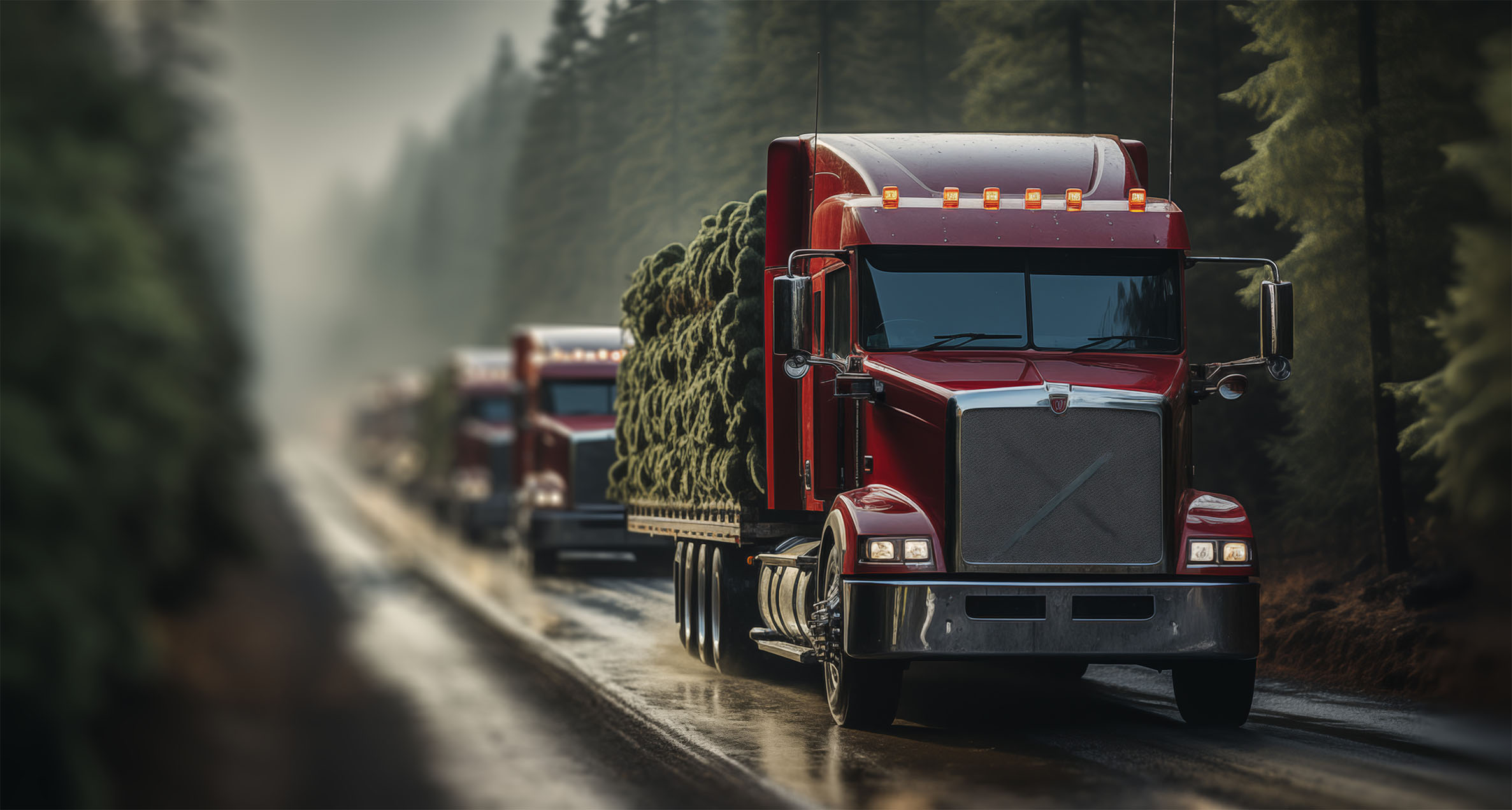As December nights grow longer, homes across America begin twinkling with the colorful glow of Christmas lights and decorations. One of the most iconic images of the season is the evergreen Christmas tree, commonly found standing proudly in living rooms and town squares across the country. For many, choosing that perfect tree feels like the unofficial start to the holiday season.
The journey that brings these trees into our homes is full of intricate coordination between growers, logistics companies, retailers, and the families keeping Christmas traditions alive. The most notable tree is of course the Capitol Christmas Tree, chosen each year to be featured prominently in Washington, D.C. This year's tree is a towering 63-foot tall gift from the Monongahela National Forest in West Virginia.
In 2023, the honor of transporting the Capitol Christmas Tree to Washington falls to Werner Enterprises, a company well known for how successfully it handles even the most complex logistical challenges. As this special operation kicks off the Christmas Tree season, Werner's fleet is ready to carry more than this single symbolic tree. They'll also shoulder the stories and spirits of countless other trees making their own trips into homes across America.
From the forests of Nova Scotia to North Carolina tree farms and the lush valleys of Oregon, each of these journeys highlights the careful planning and passion that brings holiday magic home. Today, we'll explore the hidden world behind those trees, covering everything from harvesting techniques to consumer purchasing trends. We'll reveal not only the complex, behind-the-scenes logistics operations, but also the true meaning of those journeys and how they factor into traditions old and new.
From forest to family room
The complex choreography of transporting Christmas trees across the country (and indeed the world) involves countless fleets deployed across our wintry highways. From dry van trailers in the Pacific Northwest hauling Douglas firs to the California coastline to refrigerated trucks navigating the snowy terrain of Maine bound for New York, every carrier knows this is their make-or-break season.
Many factors shape this complex journey:
Timing and destinations:
The push to get newly harvested trees on the road usually starts in November, but sometimes even earlier. Often, trucks passing through Oregon weeks before Thanksgiving are loaded with Fraser and Douglas firs destined to be holiday décor in places like Texas, Hawaii, or Mexico.
Challenges along the way:
Navigating remote farms, securing specialty equipment, coordinating multiple drops - virtually every aspect of this undertaking poses logistical hurdles. Even one severe storm or equipment failure could end in disaster for these tree shipments.
Preferred transport methods:
Customer preferences drive decision-making around optimal transportation methods. Some favor vans over refrigerated units to avoid excess airflow drying the trees. Despite risks of spoilage, others specifically request trees be packed in ice for maximum freshness.
Careful loading and offloading:
Labor-intensive offloading can take up to three days for a fully loaded truck of 800 trees. Careful coordination with local workers is essential to avoid bottlenecks.
The impacts of Christmas tree commerce
Christmas trees conjure up nostalgic ideas of family and winter wonderlands, but only rarely do we think of how these iconic evergreens represent a thriving pillar of commerce. According to the National Christmas Tree Association, there are close to 350 million Christmas trees growing across America's nurseries and family-owned farms. Of these, between 25-30 million trees are harvested each year to meet annual consumer demand.
Oregon, North Carolina, and Michigan comprise the states producing the lion's share of trees filling homes each holiday season, producing 34,068, 26,038, and 22,162 acres respectively. But the clientele served by these locally grown pines and firs extends far beyond U.S. contiguous borders. For instance, the forests of Oregon, which have historically functioned as a Christmas tree hub, ships Noble, Nordmann, and Grand firs to Hawaii, Mexico, and elsewhere. In fact, Oregon-grown firs fulfill of majority of Mexico's entire Christmas tree demand. 23 percent of all Oregon Douglas-fir are shipped to Mexico, according to the Pacific Northwest Christmas Tree Association.
Changing consumer behavior has also necessitated some nimble maneuvering by domestic tree suppliers. When drought conditions disrupted Christmas tree farming in Maine, operators adapted by arranging increased shipments from Canada to meet high seasonal demand in New England. This required a significant increase of freight transportation costs in many instances.
Both in terms of economic impact and international reach, the numbers speak for themselves. Christmas trees as a commodity extend far beyond a celebration of regional customs - they power a global exchange that shapes holiday traditions across borders.
The ingenuity behind efficient harvests
The journey from seedling to festive family rooms begins in fields and forests where Christmas trees grow. When harvest season arrives, the meticulous process of selecting, cutting, and transporting trees kicks into high gear.
Skilled workers fan out among rows of mature trees and visually grade each one based on metrics like fullness, shape, and needle retention. Only the most perfectly formed trees make the cut. (Pun intended) The tools then used to sever selected trees require precision and care to protect the integrity of the wood and branches.
Once freed from the soil, the freshly chopped trees are transported to central hubs for staging and processed. Specialized baling equipment neatly bundles them for maximizing space during transit. This streamlined approach minimizes handling to preserve freshness.
In the Pacific Northwest, Christmas tree producers even utilize helicopters for aerial transports from remote farmland. Refrigerated shipping containers then help lock in moisture and nutrients throughout the trees' journeys to destinations near and far.
From sowing to selling, today's complex Christmas tree logistics operations require both agricultural acumen and increasing ingenuity to get these emblems of seasonal joy into the homes of eager families around the world. The care and innovation producers pour into harvesting efforts sustain a ritual that has endured for generations.

North America's Christmas tree logistics
As the trade fueling these seasonal symbols extends across regions, states, and international borders alike, many forested regions across North America have gotten in on the business.
- United States: The US, particularly states like Oregon, North Carolina, and Michigan, leads in Christmas tree production and exports. Oregon had 383 growers and sold around 4.6 million trees with a sales value of $120.6 million in 2017 alone. The state ships most of its trees domestically to other states like California, Nevada, and Arizona, but sends around 16 percent of its exports (valued at $19.2 million) to Mexico.
- Canada: As a major exporter, Canada plays a pivotal role in feeding global demand. In 2020 alone, Canadian businesses shipped 2.6 million Christmas trees amounting to a staggering $78.8 million dollars. The majority of trees traveled to the United States - 96 percent of them in fact, accounting for $76.1 million dollars of those sales. New York, Massachusetts, and New Jersey rank among the biggest US importers of Canadian Christmas trees.
- Mexico: Mexico imported around 600,000 trees from Oregon and Washington in 2018. Most U.S. Christmas tree exports on their way to Mexico pass through ports along the southern border like San Diego-Otay Mesa in California, Nogales in Arizona, and Laredo in Texas.
Each of these numbers provides a clear picture of the scale and economic impact of the Christmas tree industry as it extends across North America. We can see the clear role of states like Oregon in production and export as well as the importance of Mexico as a key importer. Interstate and international trade is key for meeting consumer demand for our favorite
Market resilience in the 2022 holiday season
After six straight years of constrained Christmas tree supplies, the 2022 holiday sales season may have seemed a challenging proposition for growers. But despite market conditions, the final numbers revealed an industry proving its resilience and adaptability in fulfilling consumer demand.
Last year's data provides a snapshot into purchasing behavior nationally. The most sought-after shopping destinations for Christmas trees were chain stores and choose-and-cut tree farms. This indicates diverse consumer tastes, with some preferring the convenience of retail while others relished the nostalgia of selecting their own tree amongst snow-dusted rows of firs.
The receipts spoke for themselves in terms of industry health. 2022 sales reached 22.34 million trees at a median sticker price of $80. And the typical Christmas tree buyer keeping beloved traditions alive: young professional homeowners around 40 years old, living in households of more than 3 people.
While tight supplies spelled trouble in other industries, Christmas tree producers and retailers displayed savvy and skill balancing inventory and regional trends - all to uphold a time-honored ritual for American households.
Is E-Commerce revolutionizing tree shopping?
As the digital age continues its disruption of every consumer industry, the Christmas tree business is no exception. While it's only a budding fraction of overall sales, online Christmas tree delivery is reaching some previously underserved niches.
For instance, urbanites and more digitally-inclined millennials have indicated a strong preference in outsourcing tasks like selection, transport, and even setup. With a few clicks, they can rapidly secure a farm-fresh tree that's shipped contact-free to their doorsteps. According to data from Google trends, searches for “Christmas tree delivery” have been nearly doubling year over year, a sign of the purchasing method's mounting popularity. One survey from the National Christmas Tree Association estimated that 6 percent of trees were purchased online.
It's true that online purchases lack the nostalgic charm of wandering through tree farms, but it's a hassle-free convenience that modern consumers love. Plus, it highlights the industry's flexibility in adopting e-commerce tactics to unlock new demographics to help sustain the timeless tradition of trimming a Christmas tree.

An everlasting tradition built on adaptation
The transportation of Christmas trees from remote forests into bustling towns tells a story about both the complex mechanics that power a beloved tradition as well as the passion and care sustaining the industry. Even as consumer behavior evolves, the Christmas tree industry continues to deftly adapt. Companies pivot their business models and leverage modern tools in order to uphold this enduring symbol that marks the commencement of each year's holiday season.
Yet behind these modern innovations lies the timeless allure of gathering with loved ones in a space made more beautiful by familiar evergreen scents and colors that never fade. And even if the decorated trees of today might be almost unrecognizable to families from say 1930s America, the symbol remains as a tribute to beloved customs reinventing themselves. We can rest assured that the Christmas tree logistics industry will continue to deliver the joy discovered in the simple constants of the brightly lit evergreen.
Thank you to the drivers navigating the holiday season to make this all possible.

-2.jpg)


